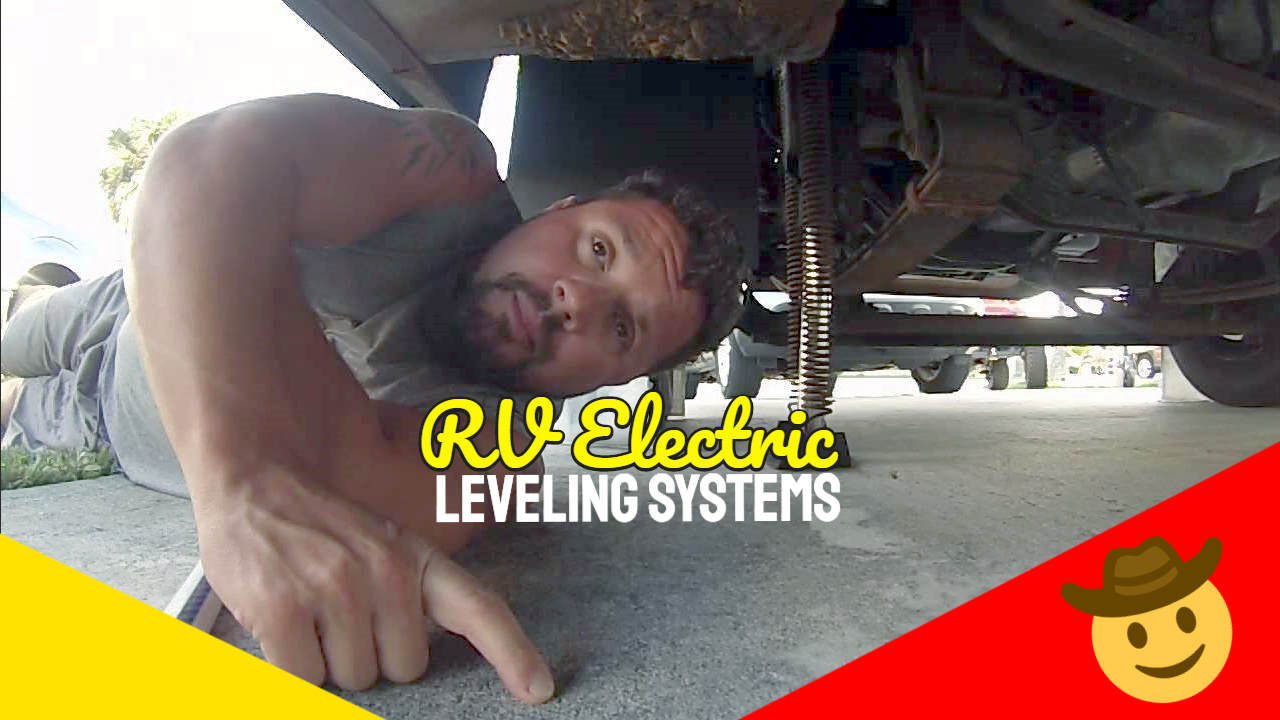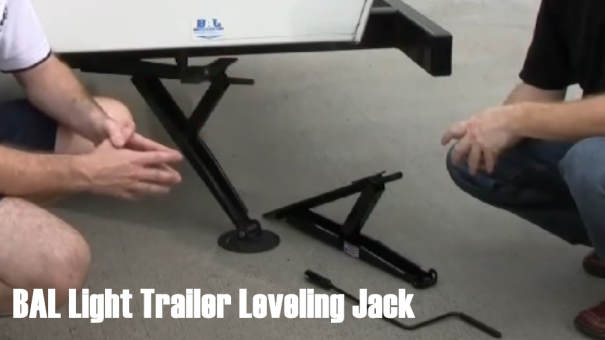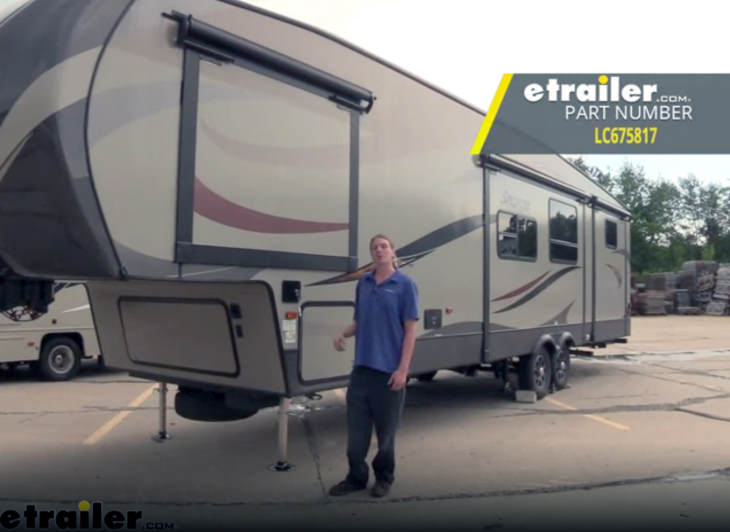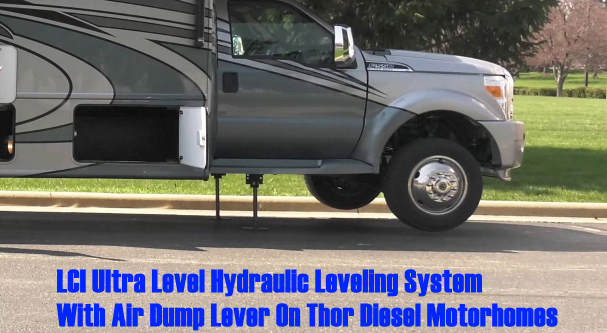A Recreational Vehicle (RV) which is fitted with the latest technology in RV electric leveling systems with automatic hydraulic jacks and stabilizers is a great boon when arriving tired at any destination. However, no automatic system can be completely foolproof. Safe RV use requires an understanding of basic RV leveling and stabilization principals. It is important that RV users take time to understand them. The following is our introduction to the subject, and we think this is essential reading for all novice RV’ers.
On This Page
- Understanding the Functions of RV Leveling Blocks, Jacks, and Trailer Stabilization
- Hand-cranked Leveling and Stabilizer Jacks
- When to Use Leveling Blocks
- Manual and Electric RV Leveling Jacks
- Manual vs Electric RV Leveling Jacks
- Tri-Lynx Leveling Blocks
- How to Level and Stabilize Your RV Using Stabilizer Jacks
- Towing Your Vehicle Behind Your RV
- Camco RV Leveling Blocks (4 Pack)
- What to Know about Manual Camper Jacks
- What to Know About Hydraulic RV Jacks
- Tips for Leveling a Travel Trailer
- What are the Best RV Leveling Systems
- Who Should Use RV Electric Leveling Systems
- What to do When RV Electric Leveling Systems Fail to Function
Understanding the Functions of RV Leveling Blocks Jacks and Trailer Stabilization
Trailer leveling and stabilization is vital whenever an RV is parked up and occupied. In fact, not to adequately level and stabilize an RV can be a safety hazard especially for the old and infirm who may easily lose their balance when a trailer is not level or moves. They may fall and injury may result.
At journey’s end leveling is done first, followed by stabilization. Both are important, neither should be neglected, and both become more vital as the size of an RV increases.

There are two main types of RV leveling blocks that are used to level your RV while static:
- interlocking leveling blocks and
- ramp leveling blocks.
Interlocking leveling blocks are plastic blocks which usually look like large “Lego blocks” which are stacked together to the desired height for easy and safe leveling.
Ramp leveling blocks are used on sloping sites to provide additional leveling when initially parking the vehicle.
The two serve very different purposes.
Wheel chocks are used to ensure no further movement of a trailer can occur.
Leveling jacks are used to lift and level the RV rig if it is parked on an uneven platform or ground, whereas stabilizers ensure that the camper is steady and reduce the amount the RV moves when walking inside it. Originally, these are hand-cranked and this technique is still used for small RV campervans.
Hand-cranked Leveling and Stabilizer Jacks

A manual scissor-type jack.
Hand-cranked scissor (threaded/ screw jacks) are the most basic form of RV leveling systems. They need to be installed every time you are making a stay during travelling.
They offer some help as motorhome or travel trailer levellers and stabilizers. That said, they have their limitations. The degree of adjustment may not be sufficient on steeply sloping pitches.
Generally, they should not be the only thing you use to level your rig, and for all but the flattest locations need to be stiffened-up by the insertion of blocks to hold the van firm under all conditions.
These simple trailer jack systems are not made to level a rig that is parked on very uneven ground. In fact, some jacks and stabilizers can damage the slide-outs of the vehicle, causing costly repairs. Fifth wheel stabilizers only stabilize, not level, the vehicle.
Stabilizer jacks extend from the bottom of your RV frame to the ground and are typically found on travel trailers and fifth wheels.
Stabilizer jacks are also referred to as leveling jacks, but it is important to note, stabilizer jacks are for stabilizing not leveling. Do not try and put the weight of the trailer on these jacks in order to level your trailer.
When to Use Leveling Blocks
If you love camping out, then you may have experienced parking on uneven ground or an unleveled area. You will know for sure that you always want to use leveling blocks unless on a very level surface area. RV electric leveling systems are very good, but they only have a certain degree of adjustment and on all but the best-prepared RV campgrounds it is important to correct for sloping pitches and uneven ground by using leveling blocks before instigating the RV electric leveling sequence.
Ignore your leveling and you will suffer from:
- things rolling off the counter,
- fridge malfunction,
- discomfort in sleeping.
Ignore your stabilizing and you will suffer from:
- bouncing and swaying of an RV
- some people even report being “giddy” or feeling queezy.
These are just are some of the side-effects of an unleveled or unstabilized RV.
So, how do you make your RV level enough to ward off the problems mentioned above?
There are lots of ways to level an RV using manual leveling jacks, hydraulic leveling system, RV leveling blocks, or ramps.
If the slope of your campsite is so drastic that hydraulic, electric or crank jacks can’t get the RV level, it’s always time to use leveling blocks.
These can also be known as jack pads, stabilizer pads, or stacker blocks). Leveling blocks can also be used in conjunction with jacks, to prevent jacks from sinking into softer terrain.
A manual jack alone cannot support the weight of your RV for a long time and may cause accidents. In extreme cases, you may end up breaking up not only your jack but also the RV frame.
Manual and Electric RV Leveling Jacks

Image courtesy eTrailer.com via YouTube.
RV leveling jacks whether you choose manual or electric versions, are a crucial part of driving and balancing the vehicle. They mainly work to ensure that your RV is secure and balanced at the right and steady angle. They work in conjunction with other components to ensure this.
There are plenty of designs that will offer different benefits to leveling your RV. However, you also get two main types of leveling jack. The manual jack and the electronic/hydraulic leveling jack. This section will discuss these two types and you’ll soon understand the best and worst qualities of both.
Electronic leveling jacks are the most convenient method when it comes to leveling out your RV. They are so simple, all it takes is for you to flick a switch and they’ll provide you with a more balanced and stable angle for your RV to rest on. However, they do take longer to initially set up as they need to be installed and connected into the RVs circuit board.
A manual leveling jack is a bit more complicated as it might take more than one person to do. Automatic RV electric leveling jacks are hassle-free when it comes to setting up, as all it takes is for you to put these underneath your RV and start cranking the jack to your desired height. They’re also less expensive than electronic models. via rvexpertise.com
Manual vs Electric RV Leveling Jacks
 It is worth looking into both types of leveling jacks, manual vs electric jacks and weigh up the pros and cons of each. Automatic electric jacks are not yet clever enough to level an RV in all circumstances. They may do a fair job on lowland campgrounds, but in mountainous areas where there is seldom a truly flat place, less so. The RV user will always need to make a good judgement on how safely levelled a van or trailer is. Manual intervention may still be needed on some sites, and if so, some would say that the point of electric leveling is lost.
It is worth looking into both types of leveling jacks, manual vs electric jacks and weigh up the pros and cons of each. Automatic electric jacks are not yet clever enough to level an RV in all circumstances. They may do a fair job on lowland campgrounds, but in mountainous areas where there is seldom a truly flat place, less so. The RV user will always need to make a good judgement on how safely levelled a van or trailer is. Manual intervention may still be needed on some sites, and if so, some would say that the point of electric leveling is lost.
A major consideration when deciding on manual vs electric jacks often rests on who you’ll be travelling with. It might be handy to have an electronic jack system installed if you’re going alone or a woman with children. If there are a few more adults going, a manual system might be an easier setup for you.
Most leveling jacks usually come as a set of two. As a minimum, they are needed as one for each axle. If your RV purchase only comes with one leveling jack, this is probably a false economy. It isn’t the best situation to be in to arrive late in the day and find that you do not have enough jacking ability to level and stabilise your van or trailer. Always try to get as many leveling jacks as possible with your RV purchase.
Tri-Lynx Leveling Blocks
In a recent article, on another leading RV blog, the author was asked which brand of leveling blocks they would themselves opt for to level their own RVs. This included the proviso that they would wish to do it in the safest, most secure manner possible.
The author replied that they would choose Tri-Lynx’s 10-pack of lynx levellers. These bright-orange blocks may be quite obtrusive, but their modular-designed levellers are very strong and can withstand very heavy amounts loadings.
Once you complete a long trip, setting up a manual scissor jack time after time, can be a tiresome exercise. If you have a taller RV, it is even more strenuous because the standard manual stabilizers are still of the standard height. When you extend manual jacks to their full height, they tend to be practically useless.
On walking through your RV, you may find yourself singing a refrain from “rock around the clock. ” It’s true, RVs, are built light for easy (and economical) travel, are not “rock solid” in camp. The longer they are, the more they tend to rock and shake as folks move about inside.
How to Level and Stabilize Your RV Using Stabilizer Jacks
Listen up, folks. Stabilizer jacks, that are attached to your RV, can be cranked down until some trailer weight is applied to the jack. However, ensure that these jacks aren’t used to lift a trailer of the ground. Stabilizer jacks are intended only to level out an RV. In other words, they should just be used for stabilizing.
RB jacks are only designed to put a little pressure to bring your RB up about two inches and that’s it. When an RV is up two inches that’s all you need. That’s plenty to stabilize it. You don’t want to lift the whole entire RV in the air! That’s so bad for the front end. But, a lot of people do that. At every park, I go to I see front ends off the ground. You don’t want to do that just touch them up about two inches just so it stabilizes the RV.
If you’re at an RV park and it’s a brick patio be courteous if you’re renting it. Put a board down so you don’t crack the bricks. You can crack the bricks with the jacks. You don’t want to do that it’s not likely, but it can happen.
Towing Your Vehicle Behind Your RV
When towing your vehicle behind your RV, it’s important to use the auto stabilization setting. This is to ensure you’re protecting yourself and others while on the road. Wheel chocks, for example, can help prevent accidental movement while towing when stationary. Safety first, always! Using chocks could be the difference in arriving at your destination or being forced to take an unexpected detour.
When it comes to stabilizing and leveling of your trailer, one thing is certain, this amazing set of RV trailer stabilizers will do wonders. In that light, we are here to discuss everything about these amazing stabilizers. So, let’s begin. The first thing that needs to be mentioned here is that there are 4 exactly the same stabilizers in the box.
Camco RV Leveling Blocks (4 Pack)
 The Camco Yellow Drive-on Tri-leveler Blocks because of the combination of price, versatility, capability, and value. Camco is a popular brand in the RV leveling industry and one look at this product will show you why. If you’re looking to have the ability to adjust your RV’s height up to 4 inches, check out the Camco Tri-levelers.
The Camco Yellow Drive-on Tri-leveler Blocks because of the combination of price, versatility, capability, and value. Camco is a popular brand in the RV leveling industry and one look at this product will show you why. If you’re looking to have the ability to adjust your RV’s height up to 4 inches, check out the Camco Tri-levelers.
There are ten of Camco’s 44505 Leveling Blocks per package. The ten blocks are affixed in an interlocked structure with an optimal height for secure leveling. The leveling blocks are not only durable, but have been specially designed to keep steady on softer soil without sinking into it.
What to Know about Manual Camper Jacks
Once you have your camper successfully leveled, it’s time to put down the stabilization jacks. If your camper has an electric stabilization jack, you can run them down from your RV, but just in case you use a manual stabilization jack, use a screw gun with the appropriate size socket to run down the jack to the ground.
The era of using manual jacks to hitch and unhitch trailers should now be long gone. Hooking a trailer to your towing vehicle tends to be physically taxing on your body. If you often haul a heavy trailer, it will soon take its toll on you.
Electric, manual, and hydraulic jacks make it so that our campers can be demounted from our trucks. Rieco-Titan, Happijac, and Stable-Lift make manufacture camper jack systems. There are many different types and capacities of jacks, and one to suit your RV. Happijac makes manual and electric ball screw jacks that come with a 1500 pound to 2800 pound capacity per jack.
What to Know About Hydraulic RV Jacks
Hydraulic leveling jacks on a motorhome can become a critical system when you least expect it. You may think they are just a convenience item — because normally they just firm up the RV and level out your position so that the refrigerator operates properly. But they really prove their worth when a wind storm comes up, or you need to get a wheel off the ground.
The patented six-point Level Up® hydraulic leveling system levels an RV in less than a minute using a one-touch auto-leveling feature, and includes an auto re-hitch memory function that remembers the exact height at which the RV was unhitched. Uneven ground can cause a lot of problems and other leveling systems can stress and twist the chassis, damaging slide systems, sidewalls and windows.
Sleepless nights in your RV with your head pointed downhill are no fun. If your trailer doesn’t have a hydraulic leveling system you’ll need to learn how to level your RV trailer.
Tips for Leveling a Travel Trailer
These easy tips to level your RV with stabilizing jacks and blocks will make the process simple and safe:
1. Leveling is imperative to keeping important systems working properly, including your RV refrigerator.
2. Take note that an RV is designed to be level. If you don’t put it on level position, you would be causing damage and other long term issues on your trailer and that would mean additional expense for repairs and replacement.
3. Always make sure that you know how to level and stabilize any RV you hire, before you set out on your first trip. When you are tired at the end of a long drive is not the time to have to get the RV Manual out and learn when everyone just wants to get into the trailer! Your rig most likely comes with a set of on-board RV leveling jacks, especially if it’s a modern model. These jacks extend down from beneath the vehicle, and are usually used in conjunction with other leveling aids, like blocks, to achieve an even coach.
4. Using RV leveler pads or blocks is simple. Just place them on the ground and drive your rig over them, or put them under your RV’s extendable leveling jacks. In a travel trailer, you may also have to use blocks under the tongue jack or even your tow vehicle’s rear tires, especially if you’re camping somewhere for just a single night and don’t want to disconnect.
5. Although your RV comes with a bubble level, it always helps to have a carpenter’s level that you can put on different areas of your RV to check your leveling.
What are the Best RV Leveling Systems
Automatic hydraulic RV electric leveling systems can save you the time and trouble of manually setting your campervan or trailer up on arrival. They are considered nowadays to be the best.
Who Should Use RV Electric Leveling Systems
If you aren’t particularly handy, can’t find someone who is experienced with RV leveling jacks, or you simply rented the RV the value of RV electric levelling systems will be immediately apparent.
If you are new to RVs and don’t want to risk damaging a system you don’t fully understand, then make sure you hire an RVs with RV electric levelling systems.
If you don’t know how to level and stabilize a hired RV, are infirm, or cannot turn a manual jack, you may find that you need to contact a motoring roadside assistance organisation, good sam’s or some similar before you can settle down and use your RV at journey’s end.
What to do When RV Electric Leveling Systems Fail to Function
Even with an automatic leveling system, you will want a backup method of ensuring level as the automatic systems occasionally go wrong. The obvious simple solution is to use a spirit level.
RV electric leveling systems might do a simple job, and they might not necessarily have a lot of complicated parts. Yet when something goes wrong, it’s usually not the sort of thing many people want to tackle themselves. If it happens don’t be too proud to ask for help. If you are in over your head, or you simply aren’t familiar with the unit, you should strongly consider seeking professional assistance.
The post RV Electric Leveling Systems Jacks and Stabilizers – An Introduction for Trailer Owners appeared first on Precious RV.
The post RV Electric Leveling Systems Jacks and Stabilizers – An Introduction for Trailer Owners appeared first on GQ Central.
Comments are closed